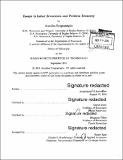| dc.contributor.advisor | David Autor and Benjamin Olken. | en_US |
| dc.contributor.author | Scognamiglio, Annalisa | en_US |
| dc.contributor.other | Massachusetts Institute of Technology. Department of Economics. | en_US |
| dc.date.accessioned | 2015-02-05T18:24:43Z | |
| dc.date.available | 2015-02-05T18:24:43Z | |
| dc.date.copyright | 2014 | en_US |
| dc.date.issued | 2014 | en_US |
| dc.identifier.uri | http://hdl.handle.net/1721.1/93817 | |
| dc.description | Thesis: Ph. D., Massachusetts Institute of Technology, Department of Economics, 2014. | en_US |
| dc.description | Cataloged from PDF version of thesis. | en_US |
| dc.description | Includes bibliographical references (pages 78-81). | en_US |
| dc.description.abstract | This thesis consists of three empirical contributions to the applied microeconomics literature. The first chapter shows that there is substantial geographical variation in the use of cesarean sections in Italy. Such variation is not driven by medical need and higher cesarean rates are achieved by performing the procedure on less and less appropriate patients. I find no evidence that high-use areas develop higher ability in performing cesareans. Finally, by using both panel data analysis and instrumental variables, I show that there is no significant relation between risk-adjusted cesarean rates and maternal and neonatal mortality. The combined evidence in this chapter suggests that lowering cesarean rates would likely affect less appropriate patients, would not have negative spillovers in terms of quality of the procedure and would not affect neonatal nor maternal mortality. The second chapter studies the response of sickness absences to changes in the replacement rate for sick leave. In June 2008 a national law modified both the strength of monitoring and the monetary cost of sick leaves for public sector employees. Using administrative data I show that absenteeism largely decreased following the reform. I identify the effects of an increase in the monetary cost of an absence using a differences in differences strategy that exploits variation in changes to the replacement rate for sick leave. Under the assumption that changes in monitoring had the same proportional impact on absenteeism within the same institutions, I estimate that a 1 percentage point decrease in the replacement rate reduces absenteeism by The last chapter investigates the effect of diffusion of organized crime on local economies by examining a legal institution that operated in Italy between 1956 and 1988. The law allowed Public Authorities to force mafiosos to resettle to another town. Using variation in the number of resettled mafia members across destination provinces in a differences-in-differences setting, I find no conclusive evidence on the effect of the policy on crime or homicides, while there is a very robust positive impact on employment in the construction sector. This result is consistent with mafia exploiting these new locations mainly for money laundering and corruption. | en_US |
| dc.description.statementofresponsibility | by Annalisa Scognamiglio. | en_US |
| dc.format.extent | 81 pages | en_US |
| dc.language.iso | eng | en_US |
| dc.publisher | Massachusetts Institute of Technology | en_US |
| dc.rights | M.I.T. theses are protected by copyright. They may be viewed from this source for any purpose, but reproduction or distribution in any format is prohibited without written permission. See provided URL for inquiries about permission. | en_US |
| dc.rights.uri | http://dspace.mit.edu/handle/1721.1/7582 | en_US |
| dc.subject | Economics. | en_US |
| dc.title | Essays in labor economics and political economy | en_US |
| dc.type | Thesis | en_US |
| dc.description.degree | Ph. D. | en_US |
| dc.contributor.department | Massachusetts Institute of Technology. Department of Economics | |
| dc.identifier.oclc | 900636024 | en_US |
